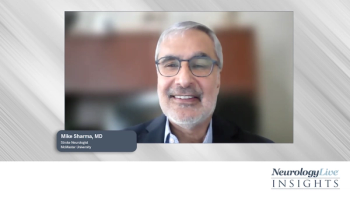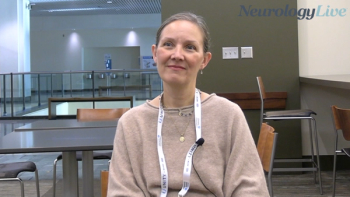
NeuroVoices: Timothy Miller, MD, PhD, on the Impact of Tofersen, Antisense Therapeutics in ALS
The codirector of the ALS Center at Washington University School of Medicine in St. Louis provided perspective on the phase 3 VALOR findings of tofersen, an antisense agent currently under review to treat SOD1-mutated ALS.
Since the disease first discovered, there have only been a handful of therapies to be approved for patients with amyotrophic lateral sclerosis (ALS). In April 2023, the agency is expected to reach a decision on a new agent, tofersen (Biogen), as it
Data from VALOR and its OLE, published in the New England Journal of Medicine, showed that tofersen did not meet its primary end point of statistically significant change in ALS Functional Rating Scale-Revised (ALSFRS-R) after 28 weeks (difference, 1.2 points; P = .97); however, it continued to demonstrate positive effects across multiple secondary and exploratory end points over a 12-month period. At the later time point, tofersen outperformed placebo on several outcomes, including clinical function, as assessed by ALSFRS-R score (difference, 3.5 points; 95% CI, 0.4-6.7) and respiratory, as measured by slow vital capacity (difference, 9.2% predicted; 95% CI, 1.7-16.6).2
Above all the findings, tofersen demonstrated a significant effect in lowering SOD1 protein, the intended target for the agent, and plasma neurofilament light, a marker of neuron injury. Additional data from VALOR and its OLE further highlighting tofersen’s impact were presented at the 2022 Annual NEALS Meeting, November 1-3, in Clearwater Beach, Florida, by lead investigator
NeurologyLive®: If it were to be approved, what role does it have among the 3 other already approved therapies?
Timothy Miller, MD, PhD: Tofersen is going way up upstream, targeting the genetic mutation in SOD1 [ALS], abnormal DNA, abnormal RNA, and tofersen is removing the RNA, or gene product. It's going way upstream in the setting of ALS. The other approved therapies aren't, as far as we know, targeting things at that level. They're targeting things that are further downstream. I would see no reason why someone couldn't be or wouldn't be on tofersen and other approved therapies for ALS. I don't see any contraindications to that at the moment. I would say they would work in conjunction with. The other point to make is people treated with tofersen did better, and I think we're doing well, but there's still room for improvement. There's not a reason not to consider all the potential therapies available to anybody with ALS.
Are there any specific advantages to tofersen?
The main advantage to this type of therapy is that it's targeting the underlying cause of the disease. I should be clear, we don't know enough about ALS to know whether other approved therapies are also targeting upstream, the underlying causes of disease. We just don't know yet. But many of us assume that a drug like tofersen for SOD1 ALS, is targeting SOD1. That's the cause of the disease. We're very upstream, removing the gene product that most of us believe is causing ALS and in people with this genetic disorder.
Have there been any discussions towards a longer trial to see tofersen’s effect?
I think all considerations are on the table right now for how tofersen may be used. I think we're gaining experience for longer treatment, and so that would be one consideration. I think another interesting point is, could we treat early with a drug like tofersen? I’m talking very, very early, and there is an ongoing trial—ATLAS (NCT04856982)—sponsored by Biogen. Michael Benetar, MBChB, MS, DPhil, is the academic lead. The idea is to follow people presymptomatically who have a known mutation, and are normal. We're going to follow that group, monitor neurofilament levels, and use the neurofilament level or symptoms that develop as a reason to convert or think about treating that person with tofersen. That's an interesting new study. I shouldn't say new, it's an ongoing study for people who are asymptomatic with SOD1 mutations, and I think we'll learn a lot from that study about hopefully preventing the occurrence of symptomatic ALS. We're catching it in its very, very earliest phase.
Regardless of approval or not, what are the main lessons learned from the clinical development and trial process of tofersen?
I think there's been a lodge for SOD1 antisense oligonucleotide therapies. SOD1 antisense oligonucleotide therapies were the first in-man delivered into the cerebrospinal fluid. Not this drug, but a predecessor of this drug. And so, we've learned a lot about how to deliver antisense oligonucleotides, and some of the nuances associated with delivery of this class of drugs that that targets RNA.
There are multiple ongoing studies across neurodegenerative diseases using this type of intrathecal delivery of an antisense oligonucleotide, many of them, in ALS. There was a program for C9orF72, a program for targeting FUS, and other program targeting ataxin-2, and there will be others coming through as well. There's a tau targeting for Alzheimer's disease and other tauopathies, and Huntington [disease] and the list goes on. Of course, a very successful approved splicing drug for spinal muscular atrophy. There's a lot of interest in development in the space of antisense oligonucleotide or RNA-targeted therapeutics.
Within ALS, we touched on this a little bit, some of the learnings are that with right drug we can move neurofilament. The substantial lowering of neurofilament with treatment of tofersen tells us about that marker and perhaps using that marker. I should comment that some successful drugs may not lower neurofilament. An example would be ones that work at the neuromuscular junction, or drugs in clinical trial focused on muscle. I wouldn't expect those to change neurofilament. A drug could be successful and not change neurofilament. But if neurofilament moves and is substantially lowered, I think that teaches us about slowing down neurodegeneration. We know that we can now use that for other studies.
The other piece that we saw and learned from this trial that we're still processing as a community was that when you look at six months, you see some effects, but they're harder to see than they are at 52 weeks. You go out to about a year, and now we see much more substantial effects. I think we're learning that it takes time to heal. It takes time to substantially lower neurodegeneration, that's what neurofilament tells us. But wow, it took some time. Maybe we need to go back and kind of think about other motor neuron disease, like Polio, for example, and how long it took to recover for some people from that hit. Even then we were quite sure that polio itself had been cleared. We're learning about the recovery process. At our institution, Washington University in St. Louis, we're beginning to think about for tofersen, how to rehab ALS. These are all new ideas, and how do we begin to do that? We will continue learning from this study, and we were thrilled to get the first publication out to the community, the New England Journal of Medicine publication in September of this year, which has most of the data that I presented at 2022 Annual NEALS Meeting. But we will continue to analyze these data and, and push out thoughts, not just for SOD1 ALS, but we hope for treatment of ALS overall, and, for antisense oligotherapeutics.
Transcript edited for clarity.
REFERENCES
1. Biogen announces FDA’s 3-month extension of review period for the new drug application for tofersen. News release. Biogen. October 17, 2022. Accessed October 17, 2022. https://www.globenewswire.com/news-release/2022/10/17/2535365/0/en/Biogen-Announces-FDA-s-3-Month-Extension-of-Review-Period-for-the-New-Drug-Application-for-Tofersen.html
2. Miller TM, Cudkowicz ME, Genge A, et al. Trial of antisense oligonucleotide tofersen for SOD1 ALS. N Engl J Med. 2022;387:1099-1110. doi:10.1056/NEJMoa2204705.
Newsletter
Keep your finger on the pulse of neurology—subscribe to NeurologyLive for expert interviews, new data, and breakthrough treatment updates.


































